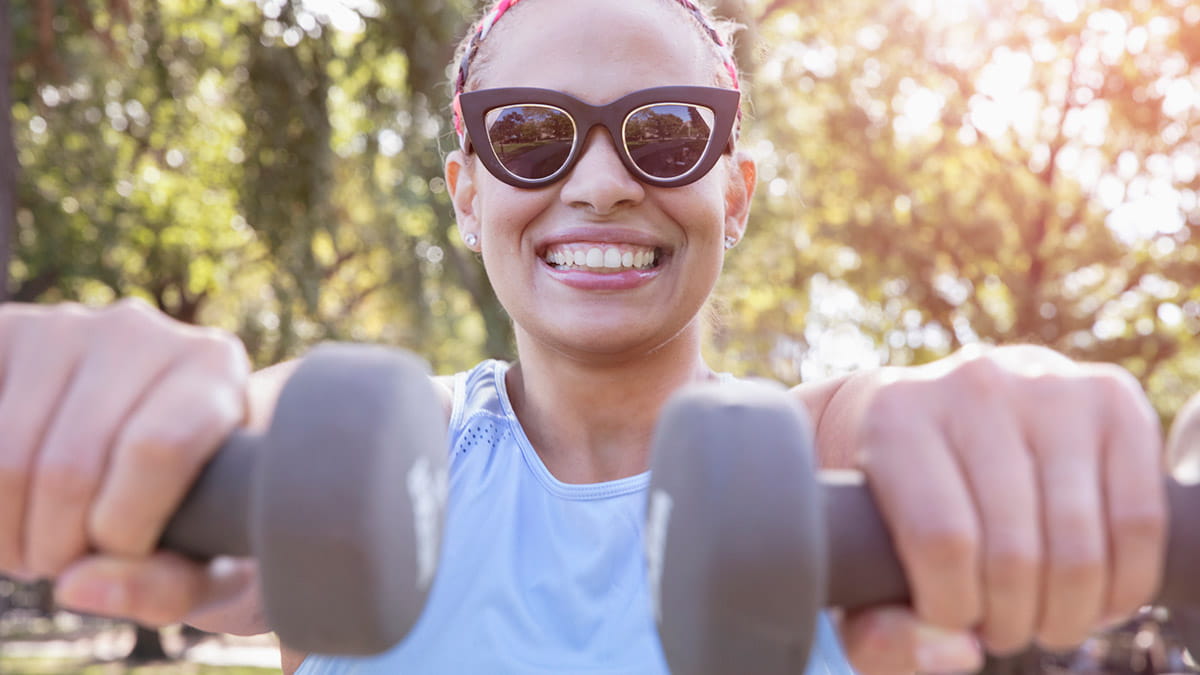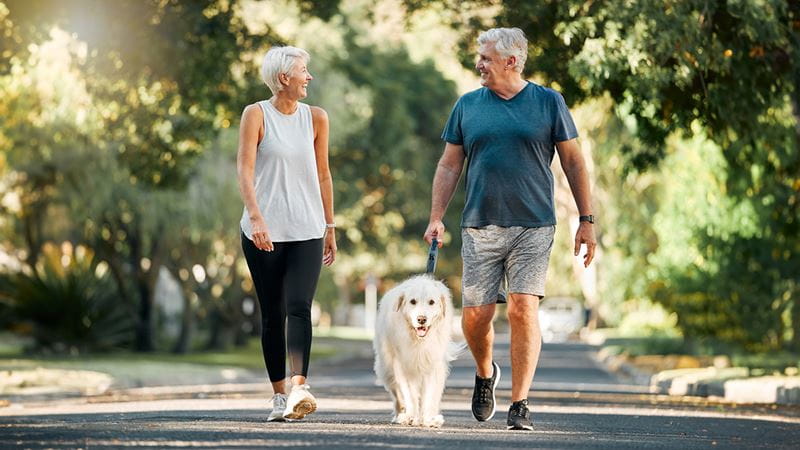Blog article
How to get fit in your 40s

Making fitness a focus in your forties can help you feel stronger and more energetic as you go about your everyday life, as well as helping set you up for a healthier future.1
Regular exercise is a proven way to help manage weight and blood pressure. It can also help reduce the risk of bone and joint problems, heart disease, stroke, cancer, Alzheimer’s and Parkinson’s.2
It can support your mental health too by improving stress levels and reducing symptoms of depression and anxiety. It can even help you get a better night’s sleep.2
How much exercise should I do in my 40s?
The Department of Health recommends that all adults try to get some physical activity every day.
That might sound over the top – but ‘physical activity’ includes things like walking and biking as well as the tried and true gym workout. It all counts!
Here’s a quick breakdown of the recommendations.
Moderate intensity physical activity
Ideally, you should aim for 2.5 to five hours of moderate-intensity physical activity a week.
Those are activities that get your heart rate up and get you sweating, but they shouldn’t leave you breathless (you should still be able to talk, but not sing.) So, it might be a brisk walk, a bike ride on relatively flat ground, or perhaps a swim. (Although swimming does tend to make both talking and singing difficult.)
Vigorous intensity physical activity
Instead of moderate activity, you could go for 1.25 to 2.5 hours of vigorous-intensity physical activity each week.
That’s activity that makes it too hard to talk, too, like jogging, a bike ride with big hills, or busting out some moves with an online dance workout video.
Like to mix it up? Another option is to do an equivalent combination of both moderate and vigorous activity.
Muscle strengthening
Finally, they also recommend muscle-strengthening exercises a couple of times a week. That could be something like weightlifting, Pilates or resistance training.
How should I get my exercise in my 40s?
How you exercise is totally up to you. The challenge for some can be getting yourself into the right mindset and then committing to it. It can sometimes be an easy thing to let slide.
Here are some tips to help you get started, and then keep going:
- Work out what activities you enjoy doing. You’re much more likely to commit to regular exercise if it’s an activity you enjoy. Don’t feel limited by thinking of exercise as something done in the gym; cycling, outdoor group fitness classes, walking on your lunch break, are all forms of exercise.
- Don’t push yourself too hard, too fast. Start with what’s achievable for you right now, and gradually build up as your fitness and confidence grows. If you’ve just taken up running, for example, don’t expect yourself to do 5km straight away. You might start with walking, then build up to a jog, then increase your distance and speed as you go.
- Find space in your schedule for exercise. If you’re not used to making exercise a priority and you have a busy life, it can feel impossible to find time for exercise. Find a convenient way you can add fitness into your daily routine. That might mean getting up half an hour early to get a workout in. Or it could be as simple as using the stairs instead of the lift or getting off the bus a few stops early and walking.
- Find a fitness buddy. Whether it’s a social tennis match with a mate or learning dance steps for your teenager’s TikTok videos, exercise is much more fun if you’re doing it with someone else. You’re more likely to feel motivated to do it and you’re more likely to keep your commitment.
What sorts of exercise should I do in my 40s?
Our forties are a great time to focus on preventative health. That means keeping up with regular health checks and developing healthy lifestyle habits to help reduce the risk of health issues that become more common as we get older, such as diabetes, high blood pressure, high cholesterol, heart disease, stroke and cancer.4
Aiming for a mix of cardio exercise (like running, cycling, swimming, group fitness classes or playing sport) and strength training (lifting weights or doing bodyweight exercises like push-ups, squats and lunges, sit-ups and pull-ups) can help you achieve and maintain a healthy weight and help prevent or manage some of these conditions.
Nutrition tips for your 40s
Eating a nutritious diet and maintaining a healthy weight is important at any age and when you are in your 40s it could be a great time to establish some lifelong healthy eating patterns.
- Eat a variety of foods from the five main food groups. Eating as close to the national guidelines as possible will help ensure you are getting all the nutrients your body needs. The five main food groups include vegetables and legumes, fruit, grains and cereals, lean meat and meat alternatives, and dairy and dairy alternatives.5
- Limit discretionary foods.Discretionary foods are those that are not needed as part of a healthy diet; things like biscuits, cakes, chips and alcohol. Choosing more whole, minimally processed foods more often and limiting these discretionary foods will help to ensure you are getting less added sugars, salt, and saturated fats in your diet.5
- Choose to cook at home. When you cook at home you are in control of what is going into your meal which generally means it’s going to be a healthier choice.6 Have fun in the kitchen, get creative with cooking techniques, try different herbs and spices, or search online for some interesting dish inspiration.
A final word on fitness in your 40s
If regular exercise hasn’t been a priority up until now, your forties are a great time to get into the habit. If you have fitness goals to achieve, don’t forget HBF can help (we’ve also got cover for physio, if you accidentally overdo it).
Good luck with your fitness goals!


